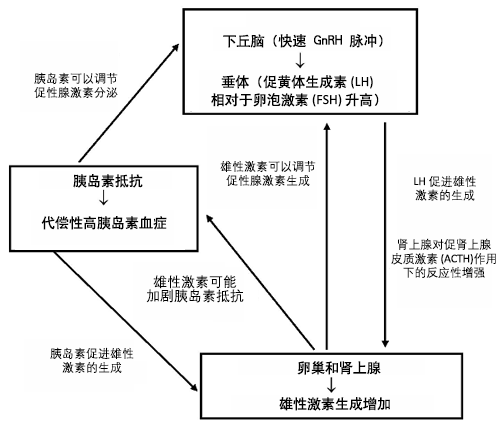多囊卵巢综合征的病因不清。这是一种累及多系统而原发缺陷部位不清楚的疾病。不同的证据显示原发性缺陷位于下丘脑-垂体轴,假定 LH 脉冲分泌幅度和频率的升高,或卵巢内源性障碍导致雄激素过度分泌;有些理论推测胰岛素敏感缺陷及胰岛素抵抗导致代偿性高胰岛素血症。
多囊卵巢综合征是一种常见的复杂性遗传疾病。此病的发病机制涉及了多基因,每个基因对总体疾病风险产生了轻微或者中度影响。[16]Goodarzi MO. Looking for polycystic ovary syndrome genes: rational and best strategy. Semin Reprod Med. 2008 Jan;26(1):5-13.http://www.ncbi.nlm.nih.gov/pubmed/18181077?tool=bestpractice.com 一项关于双胞胎的研究显示多囊卵巢综合征的遗传性在 70% 左右,这表明 PCOS 最主要的发病风险取决于遗传因素。[17]Vink JM, Sadrzadeh S, Lambalk CB, et al. Heritability of polycystic ovary syndrome in a Dutch twin-family study. J Clin Endocrinol Metab. 2006 Jun;91(6):2100-4.http://jcem.endojournals.org/cgi/content/full/91/6/2100http://www.ncbi.nlm.nih.gov/pubmed/16219714?tool=bestpractice.com 事实上一些多囊卵巢综合征的易感性基因尚未被精确识别。一项在中国人群中进行的全基因组关联的大型研究显示,在靠近或者在 3 个基因内的变异 (DENND1A,THADA,LHCGR) 是多囊卵巢综合征发病的危险因素。[18]Chen ZJ, Zhao H, He L, et al. Genome-wide association study identifies susceptibility loci for polycystic ovary syndrome on chromosome 2p16.3, 2p21 and 9q33.3. Nat Genet. 2011 Jan;43(1):55-9.http://www.nature.com/ng/journal/v43/n1/full/ng.732.htmlhttp://www.ncbi.nlm.nih.gov/pubmed/21151128?tool=bestpractice.com 在几组欧洲人群中的研究显示 DENND1A 变异与多囊卵巢综合征相关。[19]Goodarzi MO, Jones MR, Li X, et al. Replication of association of DENND1A and THADA variants with polycystic ovary syndrome in European cohorts. J Med Genet. 2012 Feb;49(2):90-5.http://www.ncbi.nlm.nih.gov/pubmed/22180642?tool=bestpractice.com[20]Eriksen MB, Brusgaard K, Andersen M, et al. Association of polycystic ovary syndrome susceptibility single nucleotide polymorphism rs2479106 and PCOS in Caucasian patients with PCOS or hirsutism as referral diagnosis. Eur J Obstet Gynecol Reprod Biol. 2012 Jul;163(1):39-42.http://www.ncbi.nlm.nih.gov/pubmed/22504079?tool=bestpractice.com[21]Welt CK, Styrkarsdottir U, Ehrmann DA, et al. Variants in DENND1A are associated with polycystic ovary syndrome in women of European ancestry. J Clin Endocrinol Metab. 2012 Jul;97(7):E1342-7.http://www.ncbi.nlm.nih.gov/pubmed/22547425?tool=bestpractice.com[22]Bao S, Cai JH, Yang SY, et al. Association of DENND1A gene polymorphisms with polycystic ovary syndrome: a meta-analysis. J Clin Res Pediatr Endocrinol. 2016 Jun 5;8(2):135-43.https://www.ncbi.nlm.nih.gov/pmc/articles/PMC5096467/http://www.ncbi.nlm.nih.gov/pubmed/26757598?tool=bestpractice.com一项随后在中国人群中的全基因组关联研究将易感基因定位点的数量增加至 11。[23]Shi Y, Zhao H, Shi Y, et al. Genome-wide association study identifies eight new risk loci for polycystic ovary syndrome. Nat Genet. 2012 Sep;44(9):1020-5.http://www.ncbi.nlm.nih.gov/pubmed/22885925?tool=bestpractice.com 两项在欧洲人群中的全基因组关联研究将 PCOS 易感基因位点的总数增加到 16。[24]Hayes MG, Urbanek M, Ehrmann DA, et al. Genome-wide association of polycystic ovary syndrome implicates alterations in gonadotropin secretion in European ancestry populations. Nat Commun. 2015 Aug 18;6:7502.http://www.ncbi.nlm.nih.gov/pmc/articles/PMC4557132/http://www.ncbi.nlm.nih.gov/pubmed/26284813?tool=bestpractice.com[25]Day FR, Hinds DA, Tung JY, et al. Causal mechanisms and balancing selection inferred from genetic associations with polycystic ovary syndrome. Nat Commun. 2015 Sep 29;6:8464.http://www.ncbi.nlm.nih.gov/pmc/articles/PMC4598835/http://www.ncbi.nlm.nih.gov/pubmed/26416764?tool=bestpractice.com 在某一种族中发现的大多数基因位点似乎影响其他种族的 PCOS 风险,这提示了 PCOS 的古老起源。[26]Azziz R, Dumesic DA, Goodarzi MO. Polycystic ovary syndrome: an ancient disorder? Fertil Steril. 2011 Apr;95(5):1544-8.http://www.ncbi.nlm.nih.gov/pmc/articles/PMC3164771/http://www.ncbi.nlm.nih.gov/pubmed/20979996?tool=bestpractice.com 易感基因位点包括 LH 受体、FSH 受体和 FSH-β 亚单位等基因,表明促性腺激素功能紊乱在 PCOS 中起关键作用。在多囊卵巢综合征患者中 X 染色体的失活证实了表观遗传学改变(不依赖于原始核苷酸序列的 DNA 改变,例如 DNA 甲基化)可能在其易感性中发挥一定的作用。[27]Shah NA, Antoine HJ, Pall M, et al. Association of androgen receptor CAG repeat polymorphism and polycystic ovary syndrome. J Clin Endocrinol Metab. 2008 May;93(5):1939-45.http://www.ncbi.nlm.nih.gov/pubmed/18303071?tool=bestpractice.com[28]Hickey TE, Legro RS, Norman RJ. Epigenetic modification of the X chromosome influences susceptibility to polycystic ovary syndrome. J Clin Endocrinol Metab. 2006 Jul;91(7):2789-91.http://jcem.endojournals.org/cgi/content/full/91/7/2789http://www.ncbi.nlm.nih.gov/pubmed/16636126?tool=bestpractice.com
 [Figure caption and citation for the preceding image starts]: PCOS 的主要致病因素的简化图来自 Dr M.O. Goodarzi 医生的个人资料;获准使用 [Citation ends].
[Figure caption and citation for the preceding image starts]: PCOS 的主要致病因素的简化图来自 Dr M.O. Goodarzi 医生的个人资料;获准使用 [Citation ends].